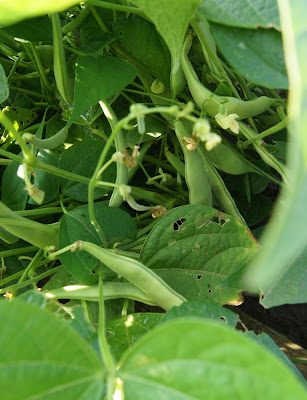So the New York Times Magazine put "Photos of your open-faced sandwich" on their "Meh List: Not Hot, Not Not, Just Meh." I don't care. I'm still excited to share our version of a Danish smorrebrod dinner, composed of slices from a beautiful rye, cracked wheat, and cider sourdough loaf topped with gorgeous things from the woods, the garden, farmers market, local farms, and Superior's clean waters. Maybe a tuna melt is meh; not this, no way.
What I loved about this meal--besides how beautiful it was, besides how wonderful it tasted--was the way it combined such an amazing diversity of local products in a plate that was beyond delicious: It was deeply and deliciously meaningful. It was the kind of thing that led me to compose the Trout Caviar Manifesto, way back when: "Our stuff is as good as anybody's stuff, and part of the reason it's good is that it's ours." I'm more convinced of that all the time, as if I should need convincing.
Let me just tell you what this was made of, and where it all came from. Oh, the smorrebrod concept, that's a Danish institution that's making a comeback and making the rounds thanks to the boom in interest in Nordic foods, foraging, and down-home ingredients. It's open-face sandwiches--knife & fork sandwiches--usually built on a thin slice of sturdy rye, well-buttered, topped with savory things. That'll work here. Hope Creamery butter, unsalted, is our daily spread.
Roast Beets and Shaved Fennel in Maple-Blackberry Vinaigrette, Hard-Cooked Farm Egg: Beets and fennel from our garden; vinaigrette with our blackberry-infused apple cider vinegar, Connorsville maple syrup, Smude Minnesota cold-pressed sunflower oil, farmers market garlic, eggs from Tina's hens
Smoked Lake Trout in Yogurt-Basil Dressing, Quick-Pickled Snow Peas, Carrot, and Onion: Everett's (Port Wing, WI) Lake Superior smoked trout; peas, carrots, jalapeno, and basil from our garden, onion from the farmers market, pickled in our cider vinegar, Connorsville honey, salt; home-cultured yogurt from Connorsville milk (and a bit of Hellmann's)
Roasted Chanterelles and Yellow Rose Finn Fingerlings with Sweet Onion and Bacon: Foraged chanterelles, farmers market potatoes and onion, home-smoked bacon, Marieke aged gouda from Thorp, Wisconsin
The chanterelles really got going last week. I brought home a couple of pounds from the Wisconsin woods. Almost as good are the yellow rose fingerling potatoes that we purchased at a Menomonie farmers market--lovely red skins and buttery pale yellow flesh. This is the kind of spud that earns an AOC. I used 7 or 8 medium chanterelles (about 2 inches across the cap), 5 potatoes, half a small sweet onion, and just a few slivers of bacon. I placed all in a gratin dish, started it at 425 and immediately turned the oven down to 350. Roast for about 30 minutes, stirring often, until potatoes and chanterelles are brown and tender. Let cool to room temperature, mound on buttered bread, top with thin slices of cheese, not too much. Of course this could be a side dish as well as a smorrebrod topping.
Roast beets in a covered baking dish at 425 until tender--40 minutes to an hour or more, it's always hard to tell with beets. I always make more beets than I need for a given dish--cooked beets are great to have in the fridge in summer for quick salads or garnish. There's often a bit of juice in the dish after roasting, and I used some in my vinaigrette this time, about a tablespoon. It can be bitter, so taste it straight up to decide if you want to use it. A little bitter is okay. It adds a spicy earthiness to the dressing. We harvested our first bulb of fennel from the garden, and it was amazingly sweet and aromatic. It was a small bulb, and I shaved half of it into the salad with the Benriner, used some greens, too.
2 teaspoons maple syrup
1 tablespoon beet roasting juice
large clove garlic minced
1 tablespoon blackberry or raspberry vinegar (or red wine or cider vinegar, just fine)
chopped fennel greens, about 1 tablespoon
lots of freshly ground black pepper
2 tablespoons sunflower oil
two good pinches salt
At the bottom of the page where Mary wrote recipe notes it says, "Outstanding." We topped the beet sandwiches with sliced hard-cooked egg and a sprig of fennel green.
I have a problematic relationship with basil. I love its summery scent, but I sort of ODed on it back in those distant days when America discovered pesto, so now I approach it warily. However, a few leaves chopped into this yogurt-mayo dressing was wonderful, especially with the smokiness of the fish.
1/4 cup yogurt
2 tablespoons mayonnaise (I didn't make this, it was Hellmann's)
chopped basil and flat-leaf parsley to taste
couple pinches salt
Mix and add to a generous cup of flaked smoked lake trout or other smoked fish--herring, whitefish, etc.
For the quick-pickled vegetables, combine in a small saucepan:
1/4 cup water
1/4 cup apple cider vinegar
2 tablespoons honey
1/2 a jalapeno seeded and slivered
1 teaspoon salt
Bring to a boil and add thinly sliced carrot (1 medium) and onion (1/2 small); simmer for 2 minutes. Add a handful of snow peas and a few shelled peas, simmer 1 minute, remove from heat. Let the vegetables cool in the brine. Use to top the trout salad.
Text and photos copyright 2012 by Brett Laidlaw




















































